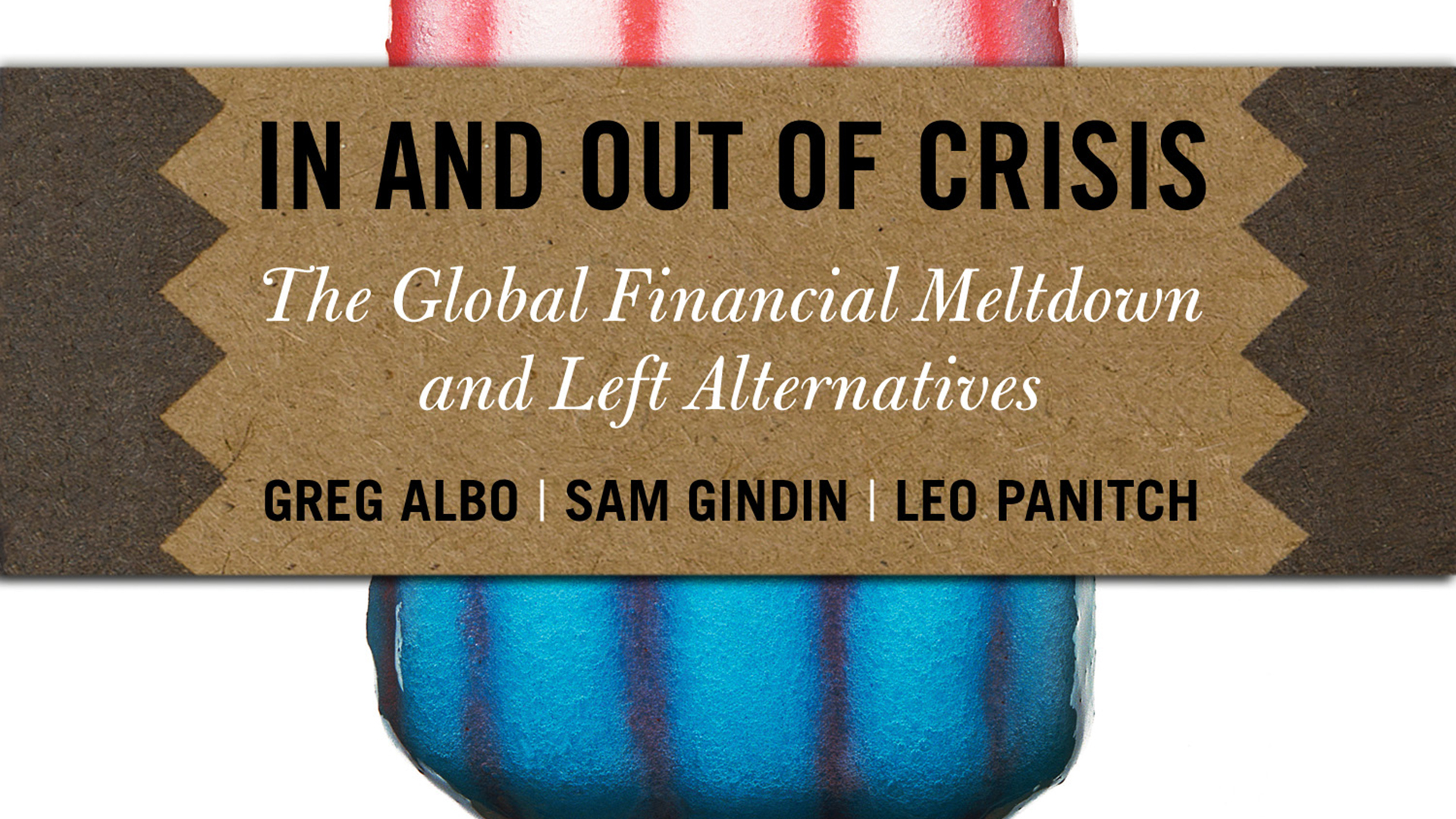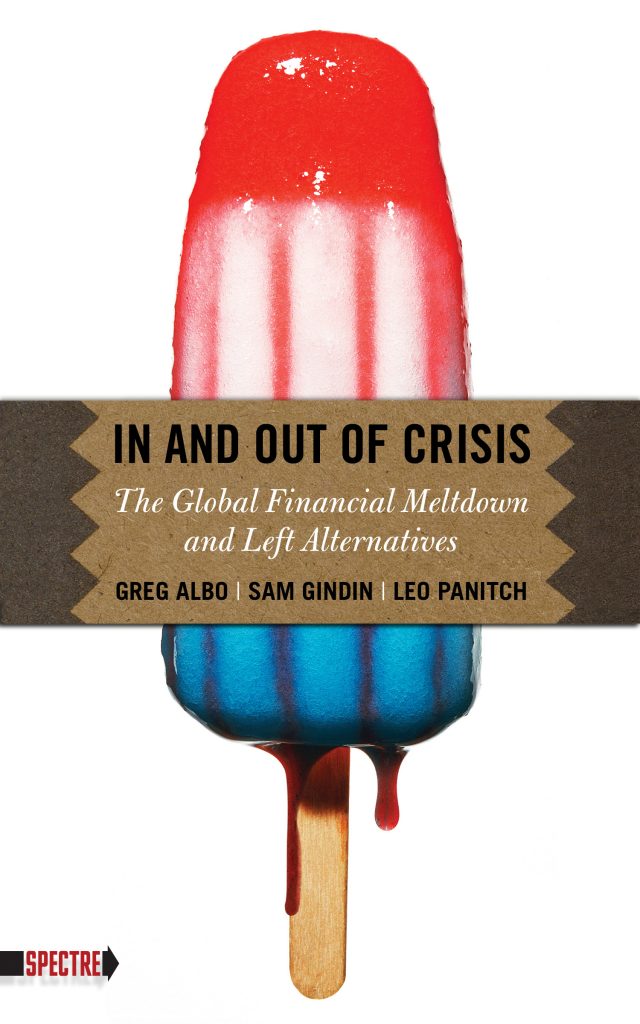by Graham Balmer
Permanent Revolution
Summer 2010
The three Canadian authors and academics, two of whom are editors of socialist register, have written a concise account of the Great recession and the tasks facing the left. The main body of the book is only about 100 pages in length but they manage to cover a great deal of ground, even though its style is a little too academic in places.
They have previously contributed more directly to debates on global political economy and the first half of this book on the origins of the financial crisis is the more insightful and stands against the current of Marxist economics exemplified by the us academic robert Brenner and supporters in the British sWp.
The subsequent sections are largely from a North American perspective and they make some very good points on the issues surrounding the rebuilding of a socialist alternative while falling short of espousing an openly Marxist programme.
It is refreshing to find an analysis of the financial crisis that is not predicated on the low profitability of capitalism: “the origins of today’s us-based financial crisis are not rooted in a profitability crisis in the sphere of production as was the case with the crisis of the 1970s.”
The idea that the almighty financial bubble, rising house prices, household debt, etc, was capitalism’s attempt to mask chronic stagnation stretching back nearly four decades is the mantra of many. it is unsupported by the uncomfortable fact that the rate of profit was not stuck in the quagmire of the 1980s but on the contrary had risen to the level of the late 1960s by 2006 – even in the “sluggish” imperialist heartlands.
As the authors say: “overall, the era of finance-led neo-liberalism experienced a rate of growth of global GDp that compares favourably with earlier periods of capitalist development over the last two centuries.”
The recent global recession “was rooted in the dynamics of finance. in spite of some important exceptions (notably in the ‘Detroit Three’), American corporations came into this crisis in generally solid financial shape in terms of profits, debt and cash flow.”
Economic crises must be placed in historical perspective and Albo et al are probably right that “there can be a general theory of capitalist development and the contradictions which lead to recurrent instability and crises within capitalism, but a ‘law of crisis’ cannot be drawn across the history of capitalism”.
The interplay between the drag on profitability (Marx’s tendency of the rate of profit to fall) and the countervailing tendencies to it (Marx again) such as rising productivity and “new zones for capitalist development in Eastern Europe, Latin America, China, and india” is missing from many contemporary theories of crisis.
All crises exhibit some obvious core features and capitalists will always take the opportunity to weaken labour, but the causes can be as different as the response of the capitalist class – compare the “Volcker shock” from 1979 with its rapid increase in interest rates to 20% to “crush inflation”, to interest rates being driven down to virtually zero in 2008-09. The authors view the actions of paul Volcker in 1979, then chair of the us Federal reserve, as one of the defining moments in the introduction of neo-liberalism as the new economic orthodoxy.
Turning to the specific role of finance in capitalist crises, there are a range of views to consider; from the failure of government policy or regulation as highlighted by Keynesians such as the us academics paul Krugman and Joseph stieglitz, through to financialisation as a symptom of decline in the “real” productive economy from Marxists at Monthly review, robert Brenner and others.
This book views finance as integral to capitalism and insists that counter-posing it to production is a false dichotomy: “Money capital, bank capital, credit and speculative capital are all necessary moments in the circuits of capitalist production and exchange. Capitalism is inconceivable without them.”
Although they argue that “fictitious capital generated in financial markets is not purely speculative in the sense that playing slot machines in a casino is speculative”, it could have been made clearer that it is only “fictitious” in the sense of being capital that is a paper claim on future profits (mortgage backed securities, etc) and is not directly invested.
This does not mean that the loanable capital that initially entered the system at the beginning of the paper trail is not “real”. The sucking in of profits into the us which were generated in the “emerging economies” was one factor in the sub-prime mortgage crisis; the capital became fictitious in the hands of Wall street but originated in the real surplus value extracted from workers in China and elsewhere.
This is identified as one reason for the financial bubble, along with the incorporation of workers into the financial system via pensions, credit cards and, of course, mortgages. The bursting of a housing bubble is a shock to the whole economic system in a way that a stock market collapse is not, as housing impacts directly on the construction industry and producers of durable consumer goods. Furthermore, for most people, the value of the family home accounts for most of their wealth.
There is an interesting discussion on the development of finance in the us and how state regulation has always served to protect the financial system; for example, the creation of the Federal reserve in the us after the banking crisis of 1907, roosevelt’s New Deal regulatory structure acting as an “incubator for financial capital’s growth and development” in the post-war period.
“The origins of today’s US-based financial crisis are not rooted in a profitability crisis in the sphere of production as was the case with the crisis of the 1970s”
Their analysis is more accurate and sophisticated than many on the left but suffers from one serious weakness. Although they are right to emphasis that finance is integral to capitalism and, most importantly, that this was not a crisis of profitability, they overplay the idea that little has changed with the credit crunch and the Great recession.
“The crisis of the empire is a crisis of all the capitalist states in the empire. There is not, in that sense, a direct relative loss of American power.”
The understandable desire to proclaim the demise of neo- liberalism and the end of us hegemony is tempting and has to be resisted when (at least to date) the Great recession has led to few fractures within the capitalist class. But it is not true that globalisation has been unaffected.
The unfolding Euro crisis and the tensions within the Europe over the bailout of Greece suggest there is significant fallout. Indeed, the whole crisis acts as a catalyst, speeding up the shift in the central axis of economic power within global capitalism, away from the G7 towards Asia.
The U.S. is still clearly the centre of global political, military and imperialist power, but this book does not really showcase the historic rise of China as an economic power over the last few decades.
The impact of the global recession in 2009 was not evenly felt, nor is the current rebound in industrial production. There has been a wide gap between the economic performance of the BriCs and Global south compared to the us, Europe and Japan.
The second part of the book covers the response of the us workers’ movement to the Great recession and offers a number of prescriptions for the way forward. As they say, “The political and economic setting facing the union movement today is, perhaps, the most difficult since the Great Depression”.
They offer a sober assessment of where the us left finds itself after decades of a neo-liberal offensive and declining union membership. There has been resistance in the us, and like in the uK including sporadic strike action and even occupations. But, to take one example, there have been few mass marches or community actions against people loosing their homes even though the foreclosure (repossession) rate has been very high in the us.
The US is still the centre of global political, military power, but this book does not showcase the historic rise of China as an economic power over the last few decades
What can be done? They identify the numerous smaller opportunities to link up industrial and community struggles, private and public sector, the unionised with the unorganised, migrant workers and environmental campaigners.
There are also the bigger national movements demanding comprehensive health care provision, an “anti-concessions campaign” (i.e. cuts in pay, pensions, severance pay, etc.) and initiatives against further anti- union legislation.
Finally, the inbuilt limitations of trade unionism means that the involvement in these struggles of organised revolutionary socialists is crucial if system-wide questions are to gain a hearing and support: the nationalisation of the whole finance system, the auto industry; workers’ control, for demands around climate change.
They put it succinctly: “The way forward is not to take one step first and another more radical step later but to find ways of integrating both the immediate demands and the goal of systemic change into the building of new political capacities.”
This is what socialists are always grappling with, and there are a great number of ideas here to commend, but they rather lose their way at the end with vague calls for a “new political instrument for social struggle” and the need to “experiment in political parties of a new kind”, without spelling out what this entails exactly in terms of methods of organisation (i.e. the balance between unity in action and democratic internal debate), controls on leaders, and how parties are to be prevented from exercising bureaucratic control over movements, as opposed to gaining leadership rights.
Back to Greg Albo’s Author Page | Back to Leo Panitch’s Author Page | Back to Sam Gindin’s Author Page







